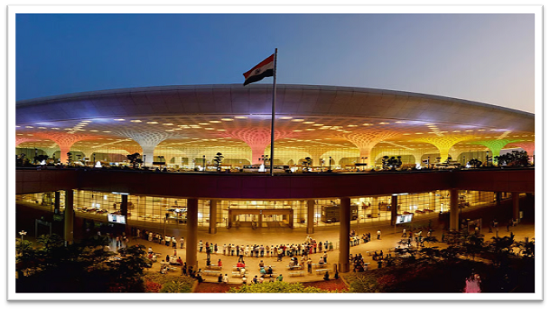
Navi Mumbai International Airport Set for Inauguration by PM Modi, India’s First Fully Digital Airport Ushers in a New Aviation Era
At 3:30 PM today, Prime Minister Narendra Modi will inaugurate Phase 1 of the Navi Mumbai International Airport (NMIA), marking a pivotal moment in India’s infrastructure and aviation trajectory. Conceived as a ₹19,650 crore greenfield project, NMIA is more than a response to congestion—it's a blueprint for how future airports in India must evolve: digitally enabled, sustainably built, and globally benchmarked.
Located in the rapidly expanding Mumbai Metropolitan Region (MMR), the airport is strategically designed to complement the already overburdened Chhatrapati Shivaji Maharaj International Airport (CSMIA), which is currently handling well beyond its intended capacity. NMIA promises to reposition Mumbai as one of the few global cities capable of efficiently operating a multi-airport system—offering relief, redundancy, and long-term resilience.
India’s First Fully Digital Airport: Seamless Travel Through Smart Technology
What sets NMIA apart is not merely its scale, but its status as India’s first fully digital airport. From the moment a passenger arrives, biometric authentication, AI-powered terminal operations, and DigiYatra integration enable a seamless, paperless journey through the airport. This marks a critical shift in how India approaches public infrastructure—not just bigger, but smarter.
Scaling for the Future: Massive Passenger and Cargo Capacity
The first phase of the airport is engineered to accommodate 20 million passengers annually. Upon full expansion, that number will rise to 90 million, with the airport operating four terminals and two parallel runways capable of simultaneous operations. This is not speculative capacity; it is calculated preparation. According to IATA, India is on track to become the world’s third-largest aviation market by 2030. NMIA is built not just to catch up, but to lead.
Architectural Innovation Rooted in Indian Identity
The terminal architecture, designed by the globally renowned Zaha Hadid Architects, marries innovation with identity. Inspired by the lotus, a symbol deeply embedded in Indian culture, the design reflects both elegance and functionality. Structural columns resemble unfolding petals, providing aesthetic distinction without compromising operational efficiency.
Multi-Modal Transport Connectivity Sets a New Standard
Connectivity is another cornerstone of NMIA’s promise. The airport will be integrated into Mumbai’s transport ecosystem through a dense network of metro lines, expressways, suburban rail, and uniquely, a water taxi service—a first for Indian airports. This multi-modal access addresses a persistent flaw in urban infrastructure planning: the lack of last-mile solutions. By pre-emptively solving for this, NMIA could redefine how India builds future transport hubs.
Built for Sustainability: Green Power and Clean Mobility
Equally critical is its sustainability profile. With 47 megawatts of solar power generation, dedicated infrastructure for Sustainable Aviation Fuel (SAF), and a fully electric bus fleet, NMIA embodies the shift toward green aviation. Its design aligns with India’s broader climate commitments and emerging global environmental standards in aviation. The Indian Green Building Council is expected to certify it with the Platinum rating, the highest available.
Streamlined Passenger Flow with High-Tech Infrastructure
Operational efficiency has been engineered into every layer. Phase 1 alone includes 66 check-in counters and 22 self-baggage drop points, designed to reduce passenger wait times significantly. An Automated People Mover (APM) is planned to eventually connect all four terminals, ensuring fluid movement across the campus even as traffic scales up.
Economic Impact: 2 Lakh Jobs and a New Industrial Corridor
Yet the implications of NMIA stretch far beyond aviation. The project is projected to generate over two lakh jobs across sectors including logistics, IT, real estate, and retail. Its emergence is expected to catalyse a new industrial corridor in the region, becoming a vital engine for local and national economic growth. The aviation sector already contributes around 2.4 percent to India’s GDP, and NMIA is poised to significantly increase that share.
All-Weather Operations with Category II ILS
Importantly, the airport is designed for reliability under challenging conditions. The runway is equipped with a Category II Instrument Landing System, enabling safe landings in visibility as low as 300 meters. This is essential for a coastal city like Mumbai, where monsoons and winter fog routinely disrupt flight operations.
Cargo and MRO Hub: Strengthening India’s Aviation Backbone
NMIA is also envisioned as a major cargo and Maintenance, Repair, and Overhaul (MRO) hub. With eventual capacity for 3.25 million metric tonnes of cargo annually, it is being positioned as a backbone for sectors ranging from pharmaceuticals and perishables to high-value manufacturing. India's air cargo sector is growing at a CAGR of 10 percent, and NMIA will play a central role in ensuring this growth is not bottlenecked by infrastructure.
Commercial Flights Begin December 2025: Major Carriers Onboard
While today’s inauguration is ceremonial, commercial operations are scheduled to commence in December 2025. Leading domestic carriers including IndiGo, Air India, and Akasa Air have already announced their plans to operate from the airport, with international carriers expected to follow.
A National Milestone in Infrastructure and Vision
The launch of NMIA is not simply the opening of another airport. It is the beginning of a new chapter in how India conceives, constructs, and scales its infrastructure. As the country aspires to become a $5 trillion economy, projects like this offer more than connectivity—they offer confidence. Confidence that India can match its ambitions with assets, and vision with execution.
For a city that moves 22 million people daily and contributes over 6 percent to the nation's GDP, Mumbai now gains not just relief from congestion, but a platform for exponential growth. And for India, NMIA marks another critical step on the runway to global stature.




